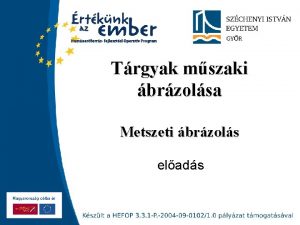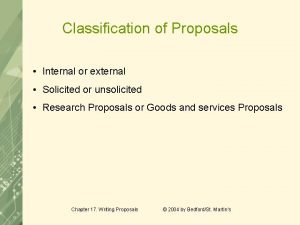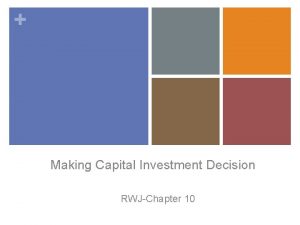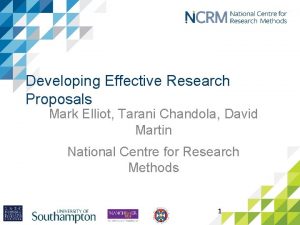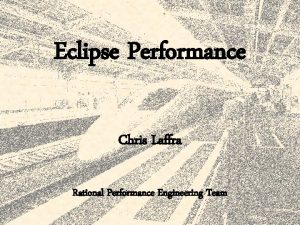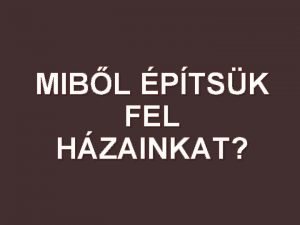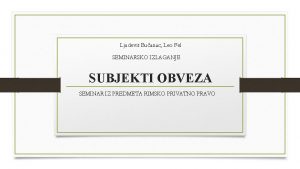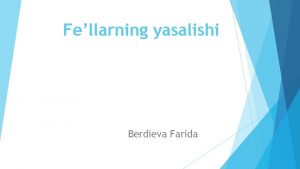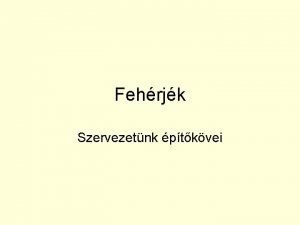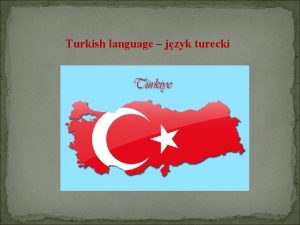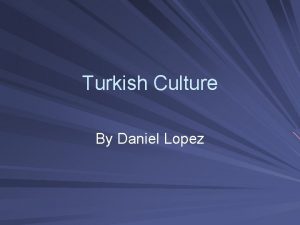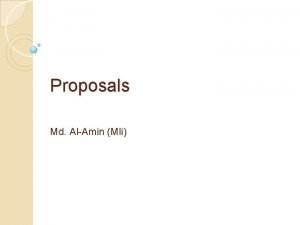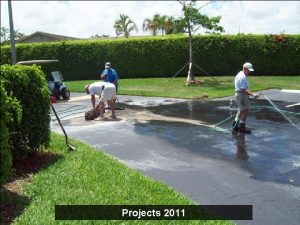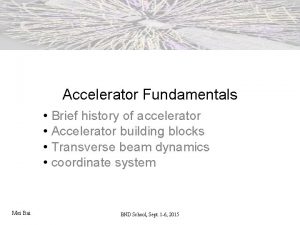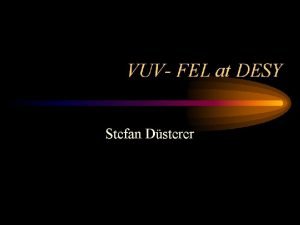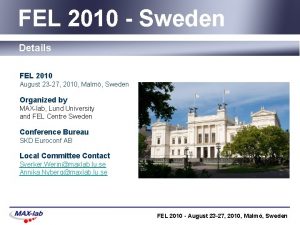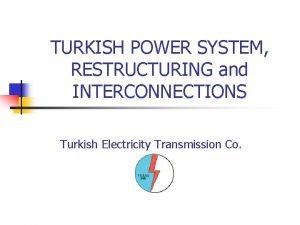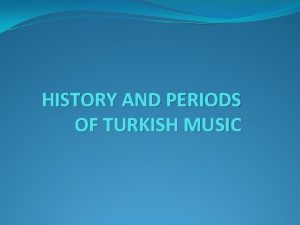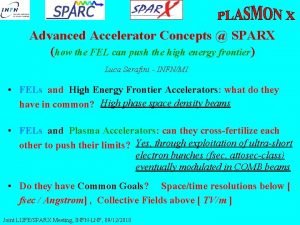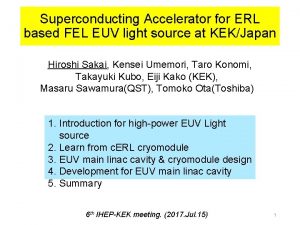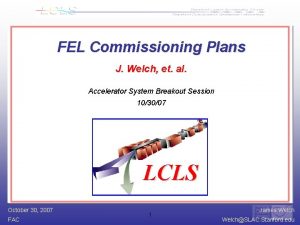Turkish FEL Projects and Proposals Turkish Accelerator and


















- Slides: 18

Turkish FEL Projects and Proposals • Turkish Accelerator and Radiation in Ankara (TARLA) Project • SASE FEL Proposal based on X-band accelerating structure Avni AKSOY Ankara University Institute of Accelerator Technologies

TARLA facility at Institute of Accelerator Technologies of Ankara University n n n The institute which is only 2 years old is the first institute established as research in the fields of accelerators and related topics in Turkey TARLA project which is essentially one of the sub‐ project of national project Turkish Accelerator Center (TAC) has been coordinated by Ankara University since 2006. TARLA facility belongs to Institute of Accelerator Technologies of Ankara University (located in Gölbaşı), and it is supported by Ministery of Development

Main goals of TARLA n n n TARLA basically proposed to generate Free Electron Laser between 3‐ 250 μm using 15‐ 40 Me. V electron beam In order to have wide research area, the electron beam is requested to be continuous wave with high current as well as pulsed with low current We plan to use high average current normal conducting injector which operates CW mode and Superconducting accelerators which are fed by solid states power amplifiers. To obtain FEL 3‐ 250 micron range using two different optical resonators with 2. 5 and 9 cm period length undulators has been proposed. . Additionally a Bremsstrahlung station is also proposed for nuclear structure and gamma radiation studies.

TARLA Layout Accelerator Electronics Power Station Bremsstrahlung Experiments γ or fixed target 5‐ 40 Me. V Accelerator Hall Injector. Linac‐ 1 Bunch Cmp Me. V Linac‐ 2 250 ke. V 5‐ 20σz=2 ps 0. 5 ps 8‐ 40 Me. V 2 ps 6 ps Cyrogenics Room FEL generation FEL F E st L e Laser at Generation io xpe ns r im en 3‐ 250 µm t

Main accelerator: SRF Module (ELBE Module) n n n Super conducting RF accelerating modules will be manufactured by Research instruments. . (Contract in 2012 Oct. , Delivery 2015 Jan. ) This module is compact and houses two TESLA cavities and is designed for continuous operation at accelerating fields in the range of 15 MV/m. The cryostat design has been developed by ELBE team (HZDR) and is used under a license agreement. Cavity frequency at 2 K 1300. 0 MHz ± 0. 05 MHz Tuning range ± 120 k. Hz External Q of input couplers (1. 2 ± 0. 2) x 107 External Q of HOM couplers > 5 x 1011 Stand by losses of cryostat < 15 W Total accelerating voltage of the module > 20 MV Dynamic losses at 20 MV cw operation < 60 W Total cryogenic losses at 20 MV cw operation < 75 W Power coupler performance (standing wave) ≥ 8 k. W Power source Bruker Solid States Amplifiers LLRF JLab digital LLRF

Laser Parameters Electron beam Parameters Main Parameters of TARLA Parameter Base Upgrade Unit 15‐ 38. 5 Me. V Max average beam current 1 1. 5 m. A Micro pulse repetition frequency 13 13‐ 26 MHz Micro pulse length 0. 5‐ 6 ps Transversal emittance < 12 <13 mm. mrad Longitudinal emittance < 50 ke. V. ps Macro pulse length CW / 40‐ 100 μs Macro pulse repetition frequency CW / 1‐ 100 Hz Beam energy Parameter U 25 U 90 Unit Wavelength 3‐ 18 17‐ 250 μm Micropulse repetition 13 13 Mhz Max. Peak Power 0. 1 – 5 0. 01‐ 2 MW* Pulse length 0. 5‐ 6 ps * Average Power 1‐ 100 1‐ 50 W* Max. Pulse energy 0. 1‐ 3 μJ*

Gun Commissioning

Time table of TARLA § § § § Completing the injector test Installation of He plant Installation of first cyromodule Installation of second cyromodule Beam at 40 Me. V Fixed target experiments Installation of lasing section FEL for users mid 2014‐ 2015 mid 2015 end of 2015 ‐ … 2015‐ 2016 2017

SASE FEL Proposal of TAC SASE‐FEL based on 1 Ge. V linac proposal was the second FEL project of TAC. It has been preliminary studied based on SC linac similar to FLASH. § The new idea is using X‐Band linac for TAC SASE FEL project proposed by CERN CLIC team by end of 2012 Oportunities § Turjey will have oportunity o transfer new technology to Turkish acclerator comminity and industry, and will have SASE FEL with huge support of CERN • Knowhow, infrastructure, development § CERN will have the opportunity to demonstrate the performance of the CLIC accelerating structures in a realistic operational environment as a user facility.

X-band Based SASE FEL Proposal § Meeting on X‐band Linac based FEL facility 17‐ 18 January 2013, Ankara, Turkey

Layout of proposed SASE FEL § 200 Me. V injector based on S band linac § 2 stage of main accelerating section based on X‐band up to 5‐ 6 Ge. V § Lasing section: several undulators or single undulator

X-band accelerating module (RF Unit) Electron linac RF unit layout based on the existing Rf sources (klystron and modulator) 2 x solid state modulators 410 k. V, 1. 6 s flat top 2 x klystrons 50 MW 1. 5 s I. Syratchev 100 MW 1. 5 s TE 01 transfer line ( RF=0. 9) x 6. 0 ~7. 3 m, 16. 3 cm TE 01 900 bend Inline RF distribution network Common vacuum network 540 MW 100 ns x 16 CLIC_502 accelerating structures use of 33. 8 MW/ structure yields 67. 5 MV/m unloaded gradient 4 m, ~3. 6 active This unit should provide ~248 Me. V acceleration beam loading. For 5 Ge. V 20 RF units are needed.

Power compression options § Repetetition rate • Klaystron power • Number of klaystrons § Number of bunches • Combination scheme < 100 Hz 50 MW 6 MW 40 320 single multi CC SLED II The user comminitee will define these options > 100 Hz

Injector S band RF Gun S band accelerating section 25 MV/m Ebeam=~200 Me. V Pin=~50 MW Tpulse=? Frep= >100 Hz § It can be similar to Swiss. FEL injector § For high repetition rate (>100 Hz) option we will have same problem for the klystrons in the injector… • Is there high repetition rate klystrons which can drive S band structures? • Or we have to make combination for the Low power High reprate klystrons? • For single bunch option shall we also use power compression?

Scanned wavelength § In order to scan large FEL wavelength ranges tunable energy 4. 5 Ge. V – 5. 5 Ge. V would not be enough

Lasing section § Lasing section should be multiple undulator line § Reducing the gradient or energy will cause longer bunch length • Slippage effect Δz ≈Nu λFEL § Shortest bunch length is required by shortest FEL wavelength

Time table for XFEL § The preparation phase, including • the Conceptual Design Report (1 Year) • the Technical Design Report (~3‐ 4 Years) Ø Ø the development of the RF gun and a klystron and 12 GHz test stand; § the construction of the injector (~2 years) § The construction of the X‐band acceleration section to 2. 5 Ge. V (~2 years) § the construction of the final stage of X‐band acceleration to 5 Ge. V. (~2 years) § installation of undulator section(s) (~2 years)

Conclusion § Turkey wants to fulfill the needs of accelerator and accelerator based technology inside country and its region within next 20 years. . § Therefore three different light source project/proposal within TAC scope is (going to be) supported step by step. . • Oscillator FEL (TARLA) under construction • Synchrotron Radiation based on 3 Ge. V ring (TDR phase) • SASE FEL project based on 5 Ge. V linac (CDR phase) § The support of CERN will be a big step towards our goals § We have a chanche to build SASE XFEL relatively cheaper by using x‐band structures. .
 Befordított metszet
Befordított metszet Writing and completing reports and proposals
Writing and completing reports and proposals Title fly and title page
Title fly and title page Title of the study
Title of the study Proposals and formal reports
Proposals and formal reports Solicited internal proposal
Solicited internal proposal Artificial intelligence thesis proposals
Artificial intelligence thesis proposals Nature of fire insurance
Nature of fire insurance When evaluating cost-cutting proposals
When evaluating cost-cutting proposals Developing effective research proposals
Developing effective research proposals Eclipse computing proposals slow
Eclipse computing proposals slow Delhi muslim proposals
Delhi muslim proposals Miből építsük fel házainkat
Miből építsük fel házainkat Adstipulatio
Adstipulatio Taqlid so'zlardan fe'l yasash
Taqlid so'zlardan fe'l yasash Fel zamonlari
Fel zamonlari Hány féle aminosav építi fel a fehérjéket
Hány féle aminosav építi fel a fehérjéket Verificador dte sat guatemala
Verificador dte sat guatemala Moodle hw
Moodle hw
